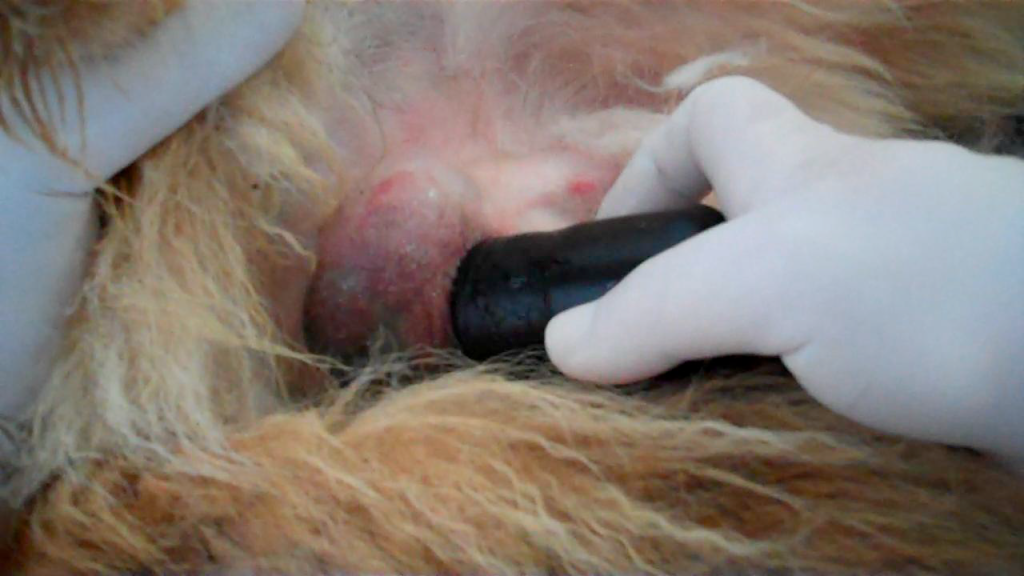The optimal ultrasound treatment regime for dog sterilization was determined, providing an option for pet owners who want birth control without the long-term health and behavior changes resulting from traditional neutering
An Italian research team led by Dr. Raffaella Leoci recently reported in Reproduction in Domestic Animals the best method for using ultrasound to sterilize male dogs. A regimen of three applications of ultrasound at 1 MHz, and 1.5 W/cm2, lasting five minutes with an interval of 48 hours was effective as permanent sterilization in the dog without hormonal impact. The ultrasound method was noninvasive, simple to administer, well-tolerated and did not alter testosterone levels.
Ultrasound and contraception
Ultrasound works through deep heating and by altering membrane permeability. Its effects have been known to influence the function of the male reproductive system since the 1970’s, when M.S. Fahim and colleagues reported that ultrasound suppressed spermatogenesis in a number of species. At the time it was hoped that ultrasound might even provide a non-invasive contraceptive for men.
The research was neglected for decades, but more recent studies have reported that while ultrasound provided permanent sterilization in rats and dogs, its effect was only transient in monkeys and humans. The size of the testes may influence the effect of ultrasound in various species. The larger testes in humans and mature monkeys may be more difficult to penetrate completely with the waves. Additionally, a large number of variables are involved with the application of ultrasound and influence its effect, including the length and timing of application, method of application, and the ultrasound device settings. These issues have made it difficult to interpret results from different studies and determine the applicability of ultrasound as a contraceptive method. The goal of the work by Leoci and colleagues was to evaluate a number of ultrasound parameters to find the most effective methodology for permanent sterilization in the dog.
The study included 100 male dogs divided into five groups, using different treatment regimens with varied combinations of ultrasound variables. Before and after treatment, researchers collected semen, tested testosterone level, and measured testicular size. After 40 days, the dogs were castrated (as in traditional neuter) and the testicular tissue evaluated. Results from the study indicated that the dogs tolerated the procedure well and, importantly, no difference in testosterone levels was evident after treatment for any group. However, details mattered: only one of the four treatment regimens caused successful contraception, with a significant reduction in testicular volume and general testicular degeneration with widespread tubular atrophy apparent from histological examination. The full study can be found open access here.
Hormone-sparing method
Traditional spay and neuter surgeries can have significant long-term effects beyond sterility. Research in the last decade has identified both positive and negative health effects of loss of hormones due to traditional sterilization procedures. For example, a recent study from the University of California, Davis found that two joint disorders and three cancers were significantly higher in both males and females compared with intact (non-neutered) dogs. For large breed dogs, the benefits of retaining normal hormone levels may outweigh the risks. Additionally, owners of dogs used for particular purposes – such as show or working dogs – usually prefer that their pet maintain testosterone levels to protect joints and ligaments from injury. As more pet owners question traditional surgical sterilization methods, nonsurgical, hormone-sparing canine sterilization methods have garnered interest.
“The ultrasound regimen we identified appears to provide permanent sterilization in male dogs without influencing testosterone levels,” reported lead researcher Dr. Raffaella Leoci. “Large scale stray dog neutering programs are not likely to benefit from ultrasound because of the time required for multiple applications and the lack of influence on testosterone-related behaviors like marking and aggression. However, the ultrasound method is ideal when a nonsurgical hormone-sparing sterilization is required.” Owners of show dogs, working dogs and breeds susceptible to health problems due to loss of hormones may be especially interested in the use of ultrasound for sterilization.
For situations in which reduction in testosterone is desired, other nonsurgical methods are available. Parsemus Foundation, which supported this project, has also partnered with Dr. Raffaella Leoci on studies which identified the most effective formulation of calcium chloride dihydrate in alcohol (also known as Calchlorin™) as a one-time intratesticular neuter shot for dogs. Unlike ultrasound, Calchlorin significantly reduces testosterone levels in dogs. Parsemus Foundation seeks to expand the options available for dog and cat reproductive control so that the best method is used for each animal.



